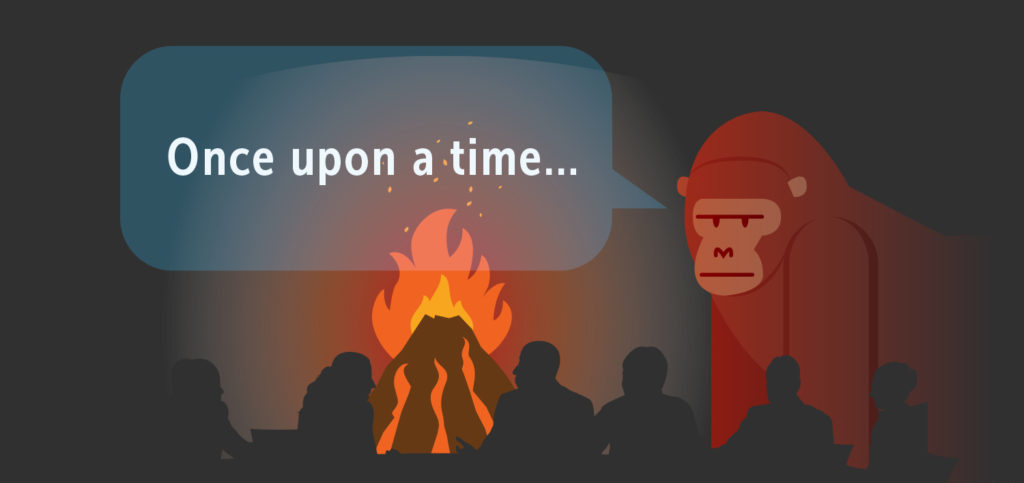It’s all about the “But” in Life Science Marketing
By David Chapin
– Third, and final, in a series –
In the first post in this series I talked about how most life science marketing stinks due to the scientists’ need for Clarity and completeness. I also introduced the idea that most effective communication in life science marketing can be boiled down to living somewhere on the Clarity vs. Mystery scale — and that too much clarity is killing life science marketing. The second post showed how injecting a little mystery into your marketing is a really good thing that increases engagement, and that asking questions—even leaving some unanswered—is usually more valuable than trying to answer everything.
In this final installment, let’s talk about the nuts and bolts of how we as life science marketing practitioners can swing the pendulum back toward Mystery and put the Clarity vs. Mystery scale into balance, thereby really connecting with our audience.
Let’s start with a key not to do.
Scientists report. Don’t.
It’s a fact, scientists report. Whether delivering a keynote, writing a scientific paper, presenting a poster or simply sharing progress with a peer or supervisor, scientists are constantly reporting. And most of this reporting is dense and complex (look it up – even the how-tos for writing scientific papers are long and complex). So it’s no wonder that this style is the preferred tactic for life science marketing and competing for new business.
As an example, we typically ask all of our new clients to do a little role-playing—pretend we are a prospect and give us your new business presentation. During this process, we see the same pattern over and over again—presentations full of charts, graphs, tables, more charts, more graphs, more tables and lots of hand-waving. The idea seems to be we’ll win them over with data, the more data, the better.
Overcompensation by over-gesticulation.
The excessive hand-waving that often goes along with the charts and graphs isn’t a requirement, but it seems to come with the territory. Usually the person presenting to us is a marketing or salesperson with a scientific background, but who may not be involved with day-to-day science anymore. Typically, these folks tend to know that their presentations lack something (they wouldn’t be working with us, for one thing, if the presentation were super-effective), but they can’t quite figure out what it is. They can tell, though, that they’re not connecting, so they overcompensate by over-gesticulating. There is definitely something to be said for being animated and full of energy, but an overdose of forced charisma is not the key to win over an audience that skews toward science—especially when the presentation itself is not compelling.
Let’s get to the root of the problem. In the process we will uncover a way to engage even if we are not physically in front of our audience.
The tool I’m going to show you works equally well for a 1 hour keynote, a new business presentation, a website case study or even a 30 second elevator pitch.
It’s called telling a story.
So, how does a scientist usually tell a story? The truth is that most scientists, when talking about their work, don’t tell stories at all. They report. According to Randy Olson, the Harvard-trained marine biologist turned Hollywood filmmaker and producer, the typical framework of a scientific presentation is something like, “and here’s my data and here’s a graph and here’s a chart and here’s another graph and here’s another and just a couple more and finally let me show you one last chart before I summarize everything in a table” [see his TEDMed Talk]. Scientists can “and” you to death, or to boredom, which is the death of real engagement. It’s why the hand-waving is so important (if my data doesn’t grab them, then my personality will).
A series of points strung together with “and” does not a story make. A story requires some tension, which is also key to adding mystery. One of the best tools I’ve ever seen for turning facts into a story is Olson’s own And But Therefore method (which he claims he mostly got from South Park creator Trey Parker).
The “And” is Act I. This is the exposition phase, or the set up. Scientists are so good at this part that they usually forget about Acts II and III. This is the “and here’s my data and a few hundred graphs” part. It’s the place where we need to ease into things, introduce the characters, set the stage, etc. This is the place to begin to connect—to get the audience to care. We’re not talking about writing novels, though. Keep this brief and get to the “But.”
The “But” (Act II) is critical. It’s where you zag after zigging or where you throw the change-up after a few fastballs in a row. In a typical drama, the “But” is when we begin to find out that the spooky caller “is in the house with us” or where we realize that the main character is now “locked in” and there is now no turning back.
The “But” is often where the critical question is asked, though we can certainly start the story with a supposition in the “And”—in which case the “But” must interject a surprise. The “But” is the “funny thing” that happened on the way to the forum. The “But” is what turns a string of sentences and facts into a story. If you didn’t introduce any tension in the “And” (and a good story will often grab and surprise right from the beginning) then you have to introduce some now. Ideally, the “Ands” build to the “But,” which then requires a release.
That release is the “Therefore.” This is Act III and it’s where the story resolves itself. As the “And” built up momentum and set the stage, the “But” hits a crescendo and the “Therefore” resolves. Once you get to the “Therefore,” you should really begin to wrap up. Act IIIs typically don’t do well if they go on too long.
So I can see the scientific brains doing one of a couple things here—either giving up because “I can’t turn all of my data into a story,” or jumping in with both feet and trying to turn ALL of the data into ONE story. Don’t do either of these. Again, a good story engages and engagement is one of the best outcomes you can hope for in working with prospects. If you’ve got 5 minutes, then one story is enough—don’t try to turn ALL of your data into one story. Pick a few salient points to set the stage (you can string them together with “Ands” if you like).
The crucial thing is to choose your “But” carefully.
Find the one data point that everything hinges on, or the surprising point. Maybe it’s not data at all. It might be a personal story: a family history with pancreatic cancer and you’re working on a therapy; a frustrating moment where things looked bleak then something funny happened that led to a breakthrough; you saw the results upside down in a mirror and had an “aha” moment. Look for something surprising that you connect with. If you feel something about the “But,” chances are others will, too.
And that’s the key to all of this. The reason to add mystery and to tell a story is to get your audiences to feel something, to make a connection. When was the last time you got “swept away by a report”? (Okay, bad example) But I’m referring to the feeling you get when you’re engaged. It’s that “it felt like I was there” that comes with good movies or novels or campfire moments. This is the kind of connection that creates a memorable, shared experience. These experiences move us. That kind of connection peppered with a little mystery and just enough data, if appropriate, can transform your life science marketing.







